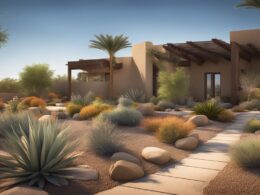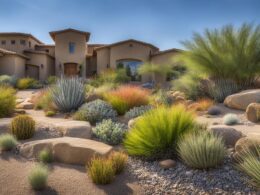Xeriscaping is a landscaping technique that allows for the creation of beautiful gardens in dry climates while conserving water. With the use of drought-tolerant plants and water-saving strategies, homeowners can transform their landscapes into sustainable and visually appealing spaces. Here are some ideas and tips for water-saving xeriscape designs.
Key Takeaways:
- Water-saving xeriscape designs are ideal for dry climates.
- Drought-tolerant landscaping can help conserve water and create visually appealing landscapes.
- Replacing lawns with water-wise plantings is a popular xeriscape design idea.
- Hardscape elements, such as circular walkways and garden art, can replace water-needy plants.
- “Hell strips” can be transformed into lush oases by planting drought-tolerant plants.
Replacing Lawns with Water-Wise Plantings
Lawns have long been a staple in front yard landscaping, but they are notorious for their high water consumption, especially in dry climates. Fortunately, there is a water-saving solution that not only conserves water but also adds beauty and diversity to your outdoor space: replacing lawns with water-wise plantings. By incorporating drought-tolerant perennials, you can create visually appealing beds that require less water than traditional grass.
Drought-tolerant perennials, such as lavender, yarrow, and salvia, are excellent choices for water-wise plantings. These hardy plants have adapted to survive in low-water conditions, making them perfect for dry climates. Their deep roots help them access water from deeper soil layers, reducing the need for frequent irrigation. Additionally, their vibrant flowers and foliage provide a burst of color and texture to your landscape, creating a visually stunning front yard.
Not only do water-wise plantings conserve water, but they also offer other benefits. They require less maintenance than lawns, saving you time and effort. Furthermore, these plants attract pollinators like bees and butterflies, promoting a healthy ecosystem in your garden. By replacing your water-thirsty lawn with water-wise plantings, you can transform your front yard into a sustainable and environmentally-friendly space.
Benefits of Replacing Lawns with Water-Wise Plantings:
- Conserves water in dry climates
- Reduces maintenance efforts
- Attracts pollinators for a healthy ecosystem
- Creates a visually stunning landscape
By embracing the idea of replacing lawns with water-wise plantings, you can contribute to water conservation efforts while still enjoying a beautiful front yard. This sustainable landscaping approach not only benefits the environment but also adds value to your property. So why not make the switch and create a water-wise front yard that is both visually appealing and eco-friendly?
Hardscaping and Art as Water-Saving Elements
In a water-saving xeriscape design, hardscape elements and art can play a crucial role in reducing water usage. By strategically incorporating hardscape features and artistic details, you can create a visually stunning landscape that requires less water to maintain.
One option is to use hardscape materials, such as pavers, to create circular walkways around a gravel center. This design not only adds an interesting aesthetic element to your yard but also helps to minimize water loss. The gravel center allows rainwater to be absorbed into the soil, reducing the need for additional irrigation.
Consider incorporating garden art, such as sculptures or decorative pieces, into your water-saving landscape. These artistic elements can serve as focal points and add beauty to your outdoor space without the need for water-needy plants. Additionally, using drought-tolerant shrubs and evergreens in your design can further reduce water consumption while still creating a lush-looking landscape.
To enhance water conservation efforts, groundcovers like thyme can be utilized to catch rainwater runoff and prevent water loss. These low-growing plants not only add visual interest but also help to retain moisture in the soil. By strategically placing them throughout your landscape, you can minimize water usage and create a more sustainable environment.
Benefits of Hardscaping and Art in Water-Saving Design
- Reduces water usage by minimizing the need for water-needy plants
- Creates visually stunning landscapes without excessive water consumption
- Provides opportunities for unique and creative design elements
- Allows for the integration of functional hardscape features, such as walkways and seating areas
- Enhances the overall sustainability of your landscape by reducing water waste and promoting water conservation
By incorporating hardscape elements and art into your water-saving xeriscape design, you can create a beautiful and sustainable outdoor space. These features not only minimize the use of water-needy plants but also add visual interest and functionality to your landscape. With thoughtful planning and design, you can achieve the perfect balance between aesthetics and water conservation.
Transforming “Hell Strips” into Lush Oases
“Hell strips,” the spaces between the curb and sidewalk, can be transformed into lush oases in water-saving xeriscape designs. By planting drought-tolerant plants like ornamental grasses, low-growing evergreens, and artemisia, rainwater runoff can be captured before it reaches the street. This reduces soil erosion, downstream pollution, and conserves water.
Creating a vibrant and water-wise hell strip requires careful plant selection. Opt for drought-tolerant varieties that can withstand the harsh conditions of these narrow spaces. Ornamental grasses, such as blue fescue and feather reed grass, add texture and movement. Low-growing evergreens like creeping thyme and woolly thyme provide groundcover and a pop of color. Artemisia, with its silver foliage, adds visual interest while being highly resistant to drought.
In addition to plant selection, incorporating permeable materials such as gravel or mulch can help with rainwater absorption. These materials allow water to filter through to the soil, reducing runoff. Adding a layer of mulch also helps retain moisture, reducing the need for frequent watering. By transforming “hell strips” into lush oases, you not only enhance the beauty of your landscape but also contribute to water conservation and a more sustainable environment.
Incorporating Fountains and Raised Ponds
When it comes to water-saving xeriscape designs, incorporating fountains and raised ponds may seem counterintuitive. However, with careful planning and design, these features can actually contribute to a water-wise yard.
By strategically choosing plants and implementing proper water management techniques, fountains and raised ponds can capture and recycle water, reducing overall water consumption. Showy foliage plants like Japanese forest grass and lamb’s ear can provide a softening effect, making the hardscaping elements visually appealing. Additionally, groundcovers such as thyme can further enhance the water-wise yard by reducing water loss and adding visual interest.
Creating a Sustainable Water Feature
When incorporating fountains and raised ponds, it’s essential to select designs that prioritize water conservation. Consider features that have recirculating pumps, allowing water to be reused rather than wasted. Opt for designs that minimize water splashing and evaporation, ensuring that the water remains within the feature as much as possible.
“Incorporating a fountain or raised pond not only adds beauty and tranquility to your landscape, but it can also contribute to water conservation efforts. With the right design and plant selection, you can create a sustainable water feature that enhances your water-wise yard.”
Achieving Visual Appeal and Functionality
When choosing plants to surround fountains and raised ponds, opt for drought-tolerant species that can thrive in dry conditions. This will ensure that the plants can withstand water scarcity while still providing a lush and visually appealing backdrop for the water feature. Consider using plants with gray or silver foliage, such as santolina and lavender, as they often exhibit excellent drought tolerance.
Remember to strategically position the fountains and raised ponds within your landscape to optimize their visual impact and functionality. Placing them as focal points or near seating areas can create a sense of serenity and provide a relaxing atmosphere for you and your guests to enjoy.
By incorporating carefully designed fountains and raised ponds into your water-saving xeriscape design, you can create a visually stunning and eco-friendly outdoor space that enhances water conservation efforts while still providing a tranquil and inviting atmosphere.
Porous Materials for Efficient Water Absorption
When it comes to creating water-saving xeriscape designs, choosing the right materials for your garden path is crucial. Porous materials, such as gravel or permeable pavers, play a significant role in efficient water absorption, preventing runoff and allowing rainwater to soak into the soil. By using these materials, you can reduce water wastage and promote healthier plant growth.
In addition to their practical benefits, porous materials can also enhance the aesthetics of your garden. The natural texture and appearance of gravel paths, for example, can add a rustic charm to your landscape. Permeable pavers, on the other hand, provide a more modern and structured look. Whatever your preferred style, incorporating porous materials into your garden path is a sustainable choice that blends functionality and beauty.
Benefits of Porous Materials:
- Efficient water absorption, reducing runoff.
- Prevents soil erosion and supports healthier plant growth.
- Enhances the visual appeal of your garden.
- Sustainable choice for water-saving xeriscape designs.
Using porous materials for your garden path not only conserves water but also adds character to your landscape. By allowing rainwater to permeate into the soil, you’re providing a natural irrigation system for your drought-tolerant plants. Embrace the beauty of porous materials while promoting a sustainable and water-wise yard.
Another water-saving strategy is to use mulch between your drought-tolerant plants. Mulch acts as a protective layer, reducing water loss through evaporation and suppressing weed growth. Opt for organic mulch, such as wood chips or straw, which not only conserves water but also enriches the soil over time.
By incorporating porous materials and mindful mulching techniques, you can create an environmentally friendly garden that thrives in dry climates. These design choices allow you to embrace both the practical and aesthetic aspects of water-saving xeriscape designs, ensuring a beautiful and sustainable landscape for years to come.
How Can Xeriscape Designs Help Conserve Water in Dry Climates?
Xeriscape design ideas homeowners can use to conserve water in dry climates include incorporating drought-resistant plants, using mulch to retain moisture, and installing efficient irrigation systems. By implementing these design ideas, homeowners can create stunning landscapes while minimizing water usage and promoting sustainability.
Conclusion
Water-saving xeriscape designs are the perfect solution for landscaping in dry climates. By implementing these designs, you can create visually stunning and sustainable gardens while conserving water.
One of the key strategies is replacing water-thirsty lawns with water-wise plantings. This simple swap not only reduces water usage but also brings beauty to your front yard. Incorporating hardscaping and art elements further enhances the aesthetic appeal of your landscape while minimizing the need for water-needy plants.
Transforming “hell strips” and incorporating fountains and raised ponds are other effective techniques. These features not only capture and recycle water but also add a touch of tranquility to your garden. Additionally, choosing porous materials for hardscaping, along with selecting drought-tolerant plants, ensures efficient water absorption and promotes sustainable landscaping.
In conclusion, water-saving xeriscape designs provide a practical and eco-friendly approach to landscaping in dry climates. By embracing these designs, you can create your dream garden while making a positive impact on the environment and enjoying cost savings. So go ahead and transform your outdoor space into a beautiful oasis that thrives even in the driest conditions.













